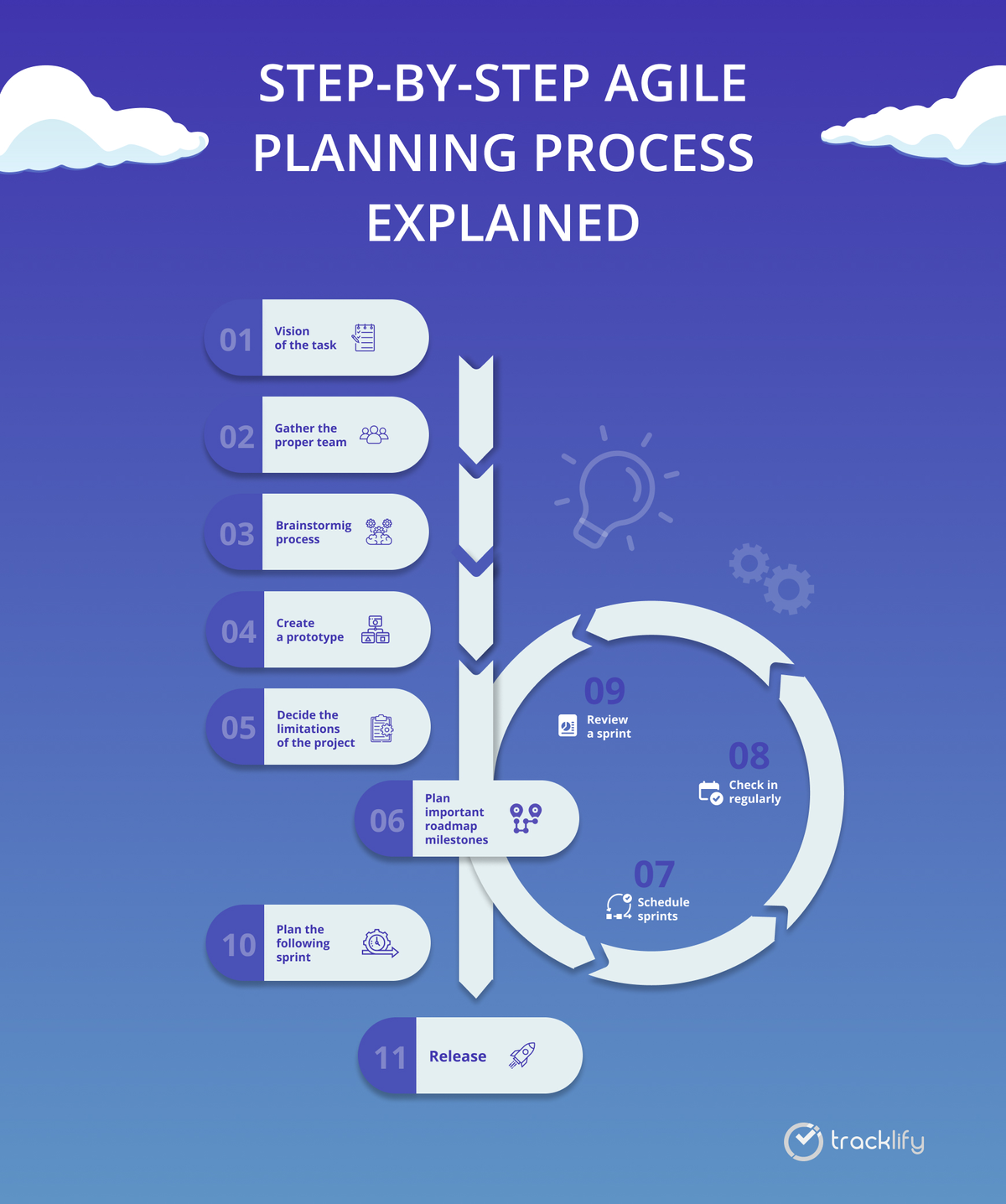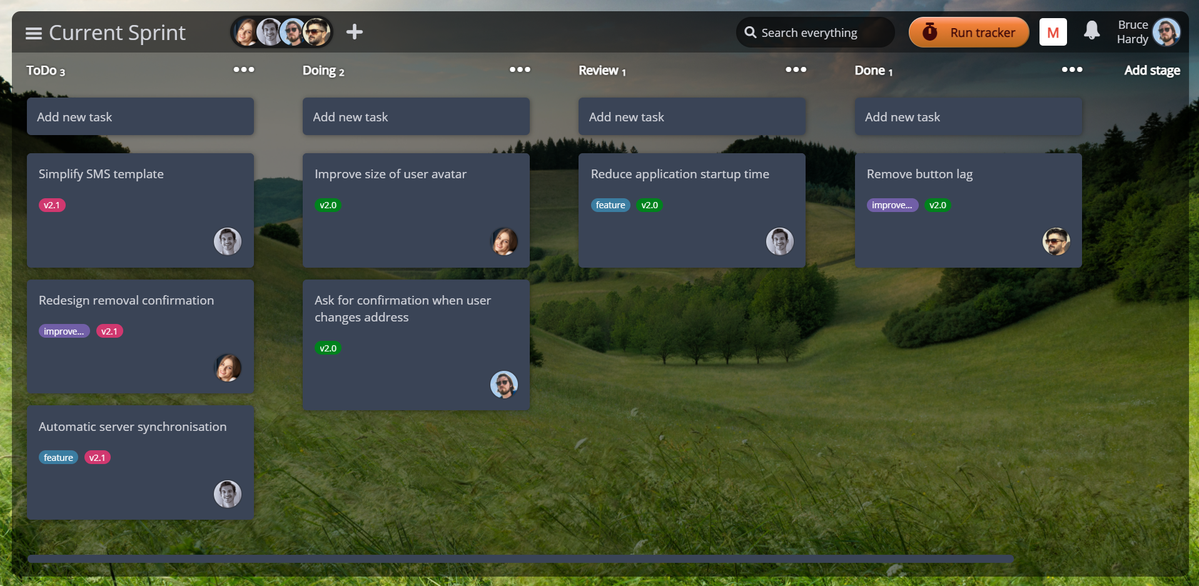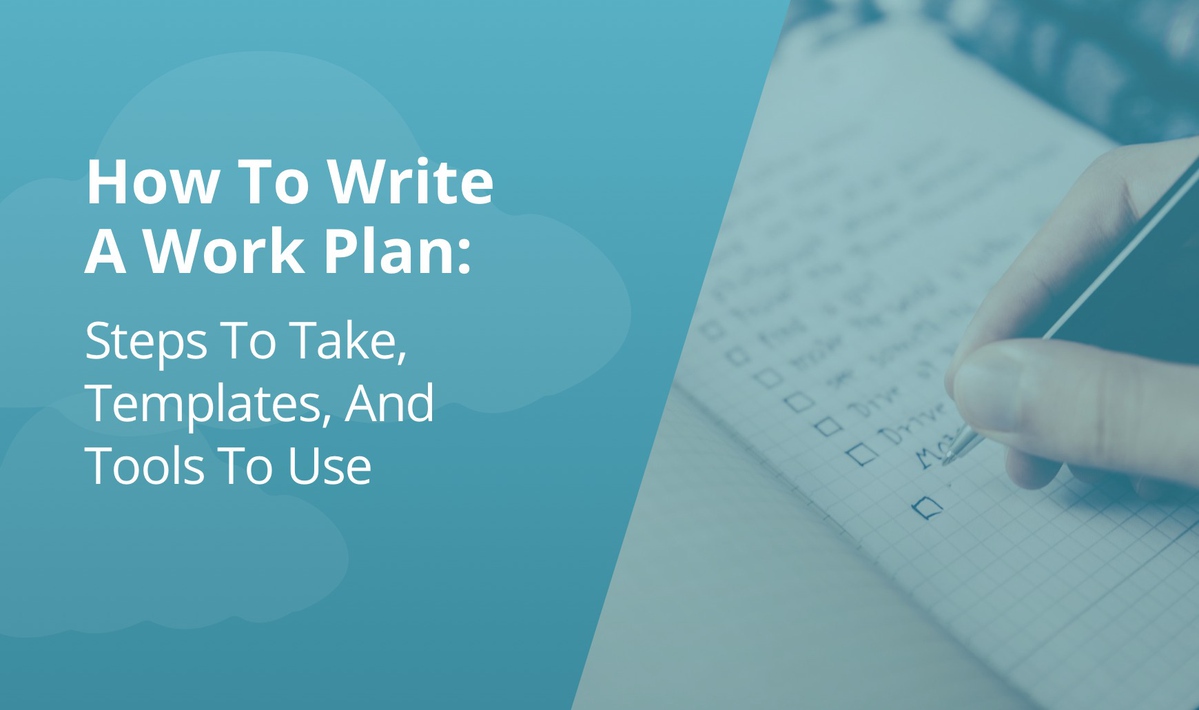The Ultimate Guide to a Productive Agile Planning Process [Bonus Templates Inside]

Planning is a very important aspect of all business projects and everyone's day-to-day activities, whether it is related to your personal planning, ordinary office tasks, or more global goals. Many of the best companies such as Apple, IBM, and Microsoft use Agile planning, but implementing Agile can be a daunting task.
But don’t worry! In this guide, you will learn all the core concepts of Agile project planning, so you can implement it for any of your goals. Plus, get free access to the Agile project templates and Agile project plan examples.
Let’s get started!
What does Agile actually mean?
Agile is a planning approach that estimates work with independent work units called sprints or iterations. One to three week intervals are called sprints in which a team concentrates on a limited load of work items as well as OKRs and strives to complete them.
Agile is a way of thinking with its own system of values, using various workflow management frameworks. A framework is a set of basic elements and rules on which you build your process. Agile is a type of philosophy which consists of four crucial values and 12 principles. It contains a number of attitudes that are followed, and they often enough have an influence on your behavior.
The major distinction between Agile and conventional (commonly known as waterfall) planning is that the former is iterative and adaptable. The second is a heavy, step-by-step planning procedure.
An Agile project planning approach doesn’t imply formalization of employee functions, hierarchy within the team, or reporting documentation. The flexibility that this method offers is also in the fact that the team closely interacts with the environment and the customers.
Thus, the final form of the project product can evolve a lot and may significantly differ from the initial idea. If we look at the statistics which suggest that 71% of organizations worldwide choose Agile methodologies for their business planning, logically it seems to be a proven method that really helps to get through the work process successfully.
These are the key features of a good Agile plan:
- The objective is from the perspective of a client
- Frequent deliveries
- Data range rather than date estimations
- Concentrate on the job not the worker
- Plans of two kinds
- Data-driven approach
Now let’s mention some Agile project plan examples. Scrum, eXtreme Programming (XP), Feature Driven Development (FDD), Dynamic Systems Development Method (DSDM), Adaptive Software Development (ASD), Crystal, and Lean Software Development (LSD) are some of the more prominent and well-known examples. Teams usually tend to choose one or two approaches at a time.
4 golden values of Agile planning
Whether you decide to use Kanban boards or Gantt charts as a specific project method, it’s important to understand the essential concepts that build the whole Agile model. You can implement those four values in various ways using each Agile methodology, but they all rely on them for the creation, delivery of high quality, and functional software.

Value 1: "People and interaction matter more than the processes and tools."
People often interpret this value as: "People are important, but tools are not important." This is not what it is about. Both people and tools are important. But what matters here is how people interact with each other. For example, in the classic approach of working in companies, the focus is, oftentimes, more on the process and the end result rather than the individuals and their behavior. But in Agile, the opposite is true: it is more important to develop the team potential and learn to work together as a collective mechanism. As a result, employees work in teams, being responsible for the result not alone, but together. This leads to a fair conclusion: During the Agile planning process, instead of counting on the performance details to push the path forward, you should encourage effective communication between team members.
Value 2: "A working software weighs more than comprehensive documentation."
The fact is that Agile also has documentation and contracts, but these components are in the background. What is more important is the final product that the client will receive and use.
A great analogy to describe this situation is this: A company orders employees to write a ton of documentation, spend time on approval, and start developing a product, but in the end the product turns out to be useless.
The reason behind this is because it took too much time to resolve those documentary issues, and there was no strength, interest, or opportunity to put energy into testing the product and getting enough feedback from the client. The bottom line: A working product always takes precedence over formal documentation. Agile places a high priority on documentation, but it places a higher value on working programming.
Value 3: "Cooperation with the customer is more important than negotiating the terms of the contract."
A lot of people tend to brush this principle off, even though it complements the very first one — the importance of human interaction. In the classical approach, the IT department and the business department work separately. The customer comes up with the topic and passes it to the developers, and six months later comes back and asks for the result. But nothing that could satisfy their concern has been done during this period.
The customer is furious, and they bring up the terms of the contract and the date of the project delivery; it doesn’t matter to them why the development department struggled with the task. In this case, the matter may be dismissed. But it wasn't the team that set the date. In other words, the interaction was not established at its greatest potential. The mission failed. Contract discussions often are there for when the client and the product manager focus on the product's details early in the process, with limited scope of adjustments along the way.
Cooperation is manifested in the fact that the attitude is changing; everyone speaks on equal terms. There is no place for hierarchy.
That’s why an Agile project management plan matters so much. It doesn’t bind you to strict rules and allows task executors to constantly check with the clients and enrich the product with new ideas and modifications.
Value 4: "Being open-minded and ready for change is more important than following the initial plan."
This principle is often misinterpreted as: "Whatever happens is change." This notion is very easy to manipulate. Let's say the product owner realized that something important was missing and everything was lost. He urgently addresses the team and states, "We have outplayed everything, we will do it like this." The team is at a loss: "We didn't agree to that," and the owner shrugs his shoulders and argues: "Well, sorry, we have to be flexible." But this principle is not at all about such chaos during the work process.
The team gathers customer opinions once a week and determines what they should alter to improve the product. Afterwards, they work toward approaching the product's owner with these desires. Work on improving the situation begins. When a team realizes, "Yes, we did the wrong thing, but we are here to think critically. Let's alter our behavior model and correct what needs to be corrected," they are ready to change.
You need to understand that the implementation and understanding of any philosophy, in our case Agile planning, takes a lot of time. When looking for new employees, be sure to tell them in detail how you work towards your product goal, so that they are fully aware and accepting of the method.
Step-by-step Agile planning process explained
Did you know that Agile initiatives offer a 90% quicker time to market than traditional project management programs? Well, here is a step-by-step approach to learn how an Agile project management plan appears in practice:

1. Vision of the task
The demands of your consumers are important to you. What do they need? What do they look forward to? What are the problems they are seeking to resolve? Agile project managers start to think of the end user. This might involve market research or consumer interviews. Simply put, you must decide how you determine whether it is successful. Functional software is there to facilitate and manage the whole process, so that you can simply update and share iterations and transfer jobs to and from your product backlog.
Teams can utilize Geoffrey Moore's "The Elevator Pitch" template from Crossing The Chasm. The template is a quick and easy method to focus your vision.
This is how the template looks:
For (target audience)
Who (dissatisfaction with the available alternatives)
The (name of the product) is a (category of the product)
That (key benefit, compelling reason to buy)
In contrast to (the alternative of the product)
Our product (how it is more efficient than its alternatives)
2. Gather the proper team
Once you have an idea of what the problem is, gathering a team of people who have the abilities and expertise to tackle the issue will be the second step. This may require external consultants from other departments to be brought in. And sometimes, you might have to develop the abilities of your current team members.
3. Brainstorming process
The team may start creating concepts immediately. All ideas should be taken into account at this point. Throughout an Agile planning process, you should foster innovations.
4. Create a base
If you have developed a possible answer, put a basic prototype together. It will just take a few days. Recall that creativity and flexibility support Agile project management. Agile release planning determines how much of the project you will deliver to the client in a certain period of time.
Share this prototype with others and write down all the comments from them. Assemble another prototype that best suits your needs if you receive mostly negative feedback. One of the main strengths of this technique is that you are informed about your design’s missed points at the early stage. You won't risk working on a concept for months just to find it isn't right for your client.
5. Decide the limitations of the project
Decide on the scope of the project based on comments. Depending on how your prototype was accepted, you may need to modify or delete features. Create a live document that outlines the scope of the project. It should be updated as the project advances.
6. Plan important roadmap milestones
The next stage is defining the milestones to be reached during the product development. You will nonetheless have to select which components are used to make the product and when each deadline should be met.
You must not just consider the characteristics of a product, but the wider objectives on which it is built. For example, does your customer aim to gain new clients, increase visibility, or increase interaction on social media? Make sure your recommended development plan matches the overall objectives of the project.
7. Schedule sprints
A sprint is a brief one- to four-week development cycle. Try to keep all sprints the same duration to ensure a consistent rate of progress. Determine a list of all your team's duties while preparing a sprint and settle on reasonable goals.
8. Check in regularly
Daily stand-ups enable you to quickly detect issues. A stand-up meeting takes around 15 minutes and asks all team members to account for their progress.
Each member of the team should be able to tell you what they worked on yesterday. Whether they have addressed problems or concerns with everyone else, you are responsible as project manager for keeping the team on schedule and working with them to address problems.
9. Review a sprint
You must sit down and review your team at the conclusion of each sprint. What did they do well? What can the next sprint teach us? Retrospectives are vital, but daily status reports are also critical for evaluating the project's health.
10. Plan the following sprint
Continue the sprint system to complete the project. Stay open and always respond to input from customers and end users. Try to always achieve perfection and never scrimp on conception. Effective Agile project administration depends on strong human connection, not only on technical skills. Select an efficient means of communication and ensure that all members of the team are committed to utilizing it.
11. Release
You may produce and release a product that your customer and end users adore. The Agile project strategy does not stop there, though — if consumers discover issues, you may need to make more changes. You will improve communication within and beyond your team with each project. You may find it difficult to adapt at first with the quick speed of Agile project management, but you'll begin to wonder how you utilized older techniques.
Agile project templates to use
Try this straightforward two-month iteration template for Agile planning purposes if you're searching for a ready-to-use Agile project template:

Agile planning with the help of a team management tool
A team management tool improves Agile planning by allowing you to design the release's user stories, arrange them into sprints, assign them to team members, and follow progress in real time from anywhere.

Here are a few more examples of how you can use Agile:
Project plan for Agile software development
The Software Development Project Plan is kept in an Excel file and contains information on each task's start and finish dates, priority, owner, and status, as well as comments. The assignments are divided into five sprints, each with its own set of features. The code is written in the code writing phase based on the features' description from the previous phase. The written code must satisfy an elementary quality barrier, and this step establishes that level and ensures that the code meets it. The purpose of user testing is to provide input to the development team. This input will be used to plan out the necessary changes and additional features.

Agile website development project plan
The website plan is kept in an Excel file that contains information about each task's start and end dates, priority, owner, progress, and comments as well. The assignments are divided into five sprints, each with its own set of features. The site mock-up is the initial task, and it shows potential users how the site will look after it is finished. The infrastructure phase entails configuring the site on the company's/clients' servers, establishing the site's domain, and performing all operations related to the site's platform.

Conclusion
The Agile method values are a great opportunity for companies to pursue their goals. Realizing how the Agile planning process works can take your business game to a whole new level. This proven technique supports trust, transparency, teamwork, and cooperation with customers. If you follow Agile ideals and principles carefully during the software development process, they will undoubtedly have a beneficial influence on the product and, ultimately, the whole business.
Are you looking for a means to correctly implement the Agile planning technique? Tracklify is a great example of an Agile planning tool that combines a task tracker app with a convenient Kanban board. We provide an intuitive user interface and powerful features that help you move your projects and business forward at a super fast speed. The best part? You can use a basic version of our software for free or go with a more advanced pro version. Sign up right now to markedly improve your planning strategy!

